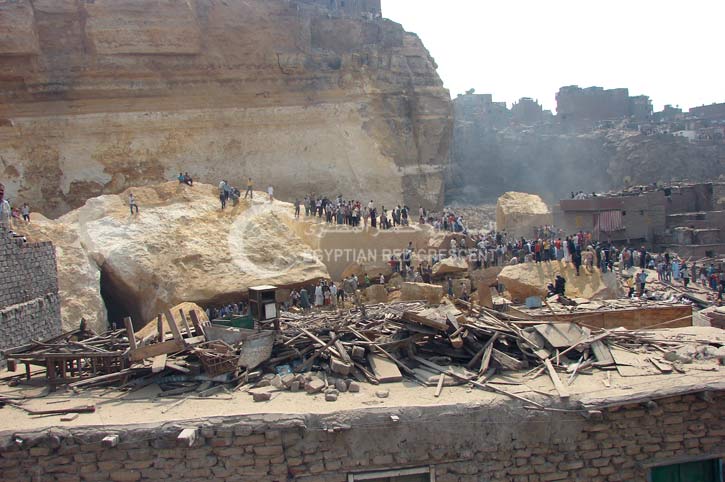10 Major Natural Disasters That Happened In Egypt
A rich cultural heritage and breathtaking landscapes await you if you visit Egypt. A fair share of devastating natural disasters has been experienced throughout history in this land of ancient civilization and natural wonders. In the face of nature’s wrath, Egypt has faced numerous challenges from the floods of the Nile River to the earthquakes that have rocked its foundations. Major natural disasters in the country have scarred people, infrastructure, and the economy. Herein we will explore some of the most significant natural disasters that have occurred in Egypt. We will delve into their causes, impacts, and lessons learned from these catastrophic events. Here are the 10 major natural disasters that have occurred in Egypt. Read on with us.
1. The 365 CE Tsunami

Image by Jensen Art Co from Pixabay
A massive earthquake with a magnitude estimated to be between 8.0 and 8.5 struck the eastern Mediterranean Sea off the coast of Greece on July 21, 365 CE. Although there were no measuring tools at the time, scientists now estimate that the quake was actually two tremors in succession. A powerful tsunami followed the quake causing widespread destruction along the coasts of the eastern Mediterranean, including the city of Alexandria in Egypt. 30 feet (9 meters) was the height of the dark waves of the tsunami.
Alexandria, one of the most important cities in the ancient world was devastated. The water near the coast receded suddenly overturning ships in the harbor at Alexandria. Then the tsunami wave rushed in and carried the ships over the sea walls. In Alexandria and surrounding villages, approximately 50,000* people were killed. Soils became barren for years as farmlands were inundated with saltwater. The larger Mediterranean region felt the quake.
2. The 1201 Earthquake

© Vyacheslav Argenberg / http://www.vascoplanet.com/, CC BY 4.0, via Wikimedia Commons
One of the world’s top ten deadliest natural disasters happened in Egypt in 1201. Killing almost 1.1 million people in two countries. Parts of Egypt, Syria and Lebanon were affected by 1201 eastern Mediterranean region earthquake according to records. The magnitude 7.6 earthquake caused significant damage to structures in affected areas. Aleppo, in modern-day Syria, is estimated to be the earthquake’s epicenter. Damascus, Egypt, and possibly even Constantinople (now Istanbul), which was the capital of the Byzantine Empire at the time felt the tremors.
In Egypt, the quake was felt as far south as Aswan and caused destruction in many cities, including Cairo, Alexandria, and Damietta. Ibn Tulun, one of the oldest and most significant mosques in the city of Cairo, lost its minaret. The quake also damaged the walls of the city’s citadel, as well as many other buildings. Alexandria city’s lighthouse collapsed because of the quake and it was one of the Seven Wonders of the Ancient World. The quake also damaged the city’s fortifications and many other buildings. The 1201 earthquake caused significant destruction in Egypt, and it took many years for the affected areas to recover fully.
3. 1754 Cairo Earthquake
A major seismic event occurred in Cairo, Egypt on the 11th of May, 1754. Widespread damage and loss of life followed the earthquake. The ground shook for approximately two minutes. It was felt throughout the city of Cairo and the surrounding areas. The southern part of the city, where many of the poorer neighborhoods were located was severely hit. Important landmarks and cultural sites were damaged. Also damaged was the Al-Azhar Mosque, one of the oldest and most important Islamic institutions in the world. 40,000* people, perished in the event. Collapsed buildings buried many people under the rubble. It was during the holy month of Ramadan that worsened the disaster as many people were up late to break their fast. The city of Cairo and the surrounding region were impacted by this quake. It is one of the deadliest earthquakes in history.
Related Read: 10 Dealiest Natural Disasters of All Time.
4. The 1992 Cairo Earthquake

United States Geological Survey, Public domain, via Wikimedia Commons
On October 12, 1992, a significant magnitude of a 5.9 earthquake on the Richter scale shook Egypt. The earthquake struck the Egyptian capital of Cairo, as well as the neighboring cities of Giza and October 6th City. According to statistics 545* people were killed, and more than 6,500* were injured. Collapsed houses left many people homeless. The movement of the African Plate, northward and collision with the Eurasian Plate caused the earthquake. The movement of the plates creates a fault system that runs through the area, leading to earthquakes such as this one. Displaced residents received financial aid and temporary housing from the Egyptian government. The 1992 Cairo earthquake was a significant event that caused widespread damage and loss of life.
5. The 1994 Sinai Earthquake
Egypt experienced an earthquake with a magnitude of 5.8 on the Richter scale on September 4, 1994. Nuweiba, in Egypt’s Sinai Peninsula, was the epicenter. It was felt everywhere in the region. Numerous towns and villages were affected by the earthquake, which caused significant damage to the region. The town of Nuweiba was the most impacted and many houses were annihilated, and people were harmed or killed. A landslide blocked the main road that connects Nuweiba and Taba, a nearby city. The earthquake was felt by Saudi Arabia, Jordan, and Israel. There was minor damage to buildings and several injuries in the Israeli city of Eilat. In Jordan, the tremor was felt in a few urban communities, including Aqaba. Although the 1994 Sinai earthquake was not the strongest one to strike the region, the damage it caused made it significant.
Watch a Natural Disaster Movie Now! CLICK HERE
6. The 2010 Alexandria Floods
Devastating flash floods struck Alexandria, Egypt, on October 28, 2010. Known as the 2010 Alexandria floods it was caused by heavy rainfall that lasted for several hours. There was a sudden rise in the water levels in the city’s streets and neighborhoods, which in turn caused the flood. The floods destroyed many homes and businesses completely and also caused significant damage to vehicles, infrastructure and buildings. According to reports, the flood caused at least 20 deaths and dozens of injuries. The Egyptian government sent aid as a result of the flood, giving support during the crisis to those impacted. Poor urban planning, inadequate infrastructure and inadequate drainage systems were blamed for the severity of the flooding. Steps to improve the city’s infrastructure and drainage systems have since been taken by the Egyptian government.
Learn Some Facts about Natural Disasters.
7. The 2017 Red Sea Floods

Image by Gerd Altmann from Pixabay
The Red Sea region experienced severe flooding due to heavy rainfall in 2017. Egypt, Yemen, Saudi Arabia, and Sudan were impacted by the flooding. The floods affected Egypt’s Red Sea Governorate, which is located in the southeastern part of the country. Major infrastructure, including roads, bridges, and buildings were swept away by water. Also negatively impacted was the tourism industry, which is an important source of income for the region. People were displaced and thousands were forced to seek shelter in temporary camps on dry grounds.
Farmers and other rural residents lost crops and livestock. The Egyptian government deployed emergency response teams and provided assistance to those affected by the disaster. The government also pledged to provide financial support for the reconstruction and repair of damaged infrastructure. Generally, the 2017 Red Ocean floods were an overwhelming cataclysmic event that caused huge harm and death toll in a few nations in the locale.
8. The 1996 Nile Delta Earthquake

Al-Ahram (State-owned newspaper), Public domain, via Wikimedia Commons
The city of Dakahlia, about 130 kilometers north of Cairo was the epicenter of the earthquake. The city of Mansoura was annihilated in particular the earthquake caused significant damage to buildings and infrastructure in the region. The death toll from official reports stands at over 550 people and 6,500 were injured as a result of the earthquake. The earthquake was caused by movement along the Damietta fault system, which runs parallel to the Nile River.
This fault system has been responsible for several historical earthquakes in the region, including a magnitude 7.3 earthquake in 1303 that caused widespread damage and fatalities. The 1996 Nile Delta earthquake highlighted the need for improved building codes and seismic-resistant construction in Egypt, which is situated in a seismically active region. Efforts have been made to strengthen existing structures and enforce stricter building codes for new construction since the earthquake.
9. The 2008 Qena Earthquake
Qena governorate in Upper Egypt was the epicenter of this earthquake which was located about 60 kilometers (37 miles) southeast of Luxor. The 2008 Qena earthquake was a moderate earthquake with a magnitude of 5.1 on the Richter scale. Ancient temples and tombs in Luxor including several buildings were damaged in the area. Many residents rushed out of their homes in panic. A wide area of southern Egypt and northern Sudan felt the upheavals of the earthquake.
The earthquake was caused by the movement of the Arabian Plate and the African Plate along the East African Rift System. Seismic activity is common in this region, with several earthquakes occurring in the area each year. Fortunately, there were no reports of fatalities from the earthquake. However, it served as a reminder of the need for earthquake preparedness in the region, as well as the importance of protecting cultural heritage sites from natural disasters.
Related Read: 10 Deadliest Natural Disasters in India.
10. 2008 Duweika, Cairo Rockslide

Egyptian Red Crescent Society, Public domain, via Wikimedia Commons
The 2008 Duweika rockslide occurred on September 6, 2008, in the Duweika neighborhood of Cairo, Egypt. Heavy rains triggered the rockslide that collapsed several buildings. This led to the deaths of at least 107 people, with many others injured or logged as missing. The unstable geology of the area, the heavy rainfall, and the poor construction of many of the buildings in the neighborhood caused the rockslide. The Duweika area is located on the edge of the Muqattam Hills. The hill is composed of limestone and other sedimentary rocks that are prone to erosion and instability. The tragic rockslide highlighted the need for better building codes and infrastructure in Egypt. In the aftermath of the disaster, there were calls for increased government oversight and regulation of construction practices, as well as efforts to improve emergency response and disaster preparedness in the country.
Egypt has faced its fair share of major natural disasters throughout its rich history. From earthquakes and floods to sandstorms and heatwaves, these events have tested the resilience of the Egyptian people time and time again. The incredible strength and perseverance of the Egyptian spirit has shone through despite the devastation that these disasters have caused. As the country continues to face new challenges in the future, the people of Egypt will continue to rise to the occasion with the same courage and determination that has defined them throughout history.
Planning a trip to Paris ? Get ready !
These are Amazon’s best-selling travel products that you may need for coming to Paris.
Bookstore
- The best travel book : Rick Steves – Paris 2023 – Learn more here
- Fodor’s Paris 2024 – Learn more here
Travel Gear
- Venture Pal Lightweight Backpack – Learn more here
- Samsonite Winfield 2 28″ Luggage – Learn more here
- Swig Savvy’s Stainless Steel Insulated Water Bottle – Learn more here
Check Amazon’s best-seller list for the most popular travel accessories. We sometimes read this list just to find out what new travel products people are buying.









